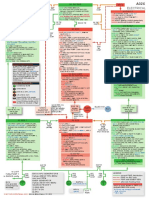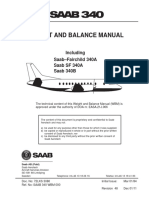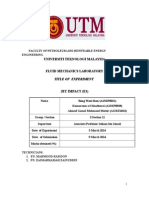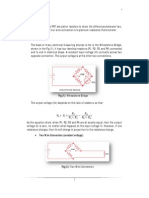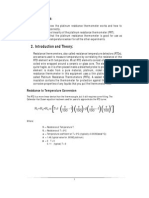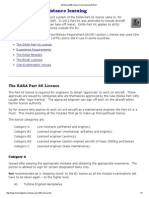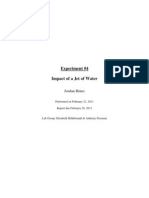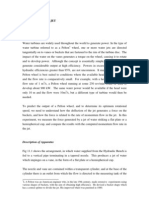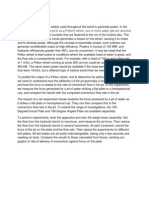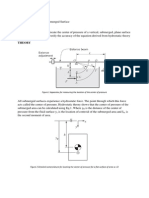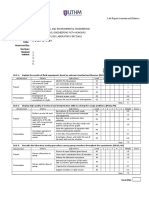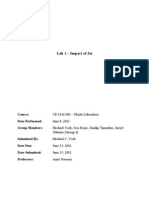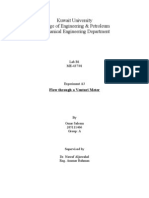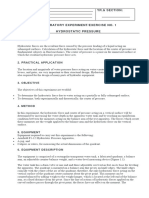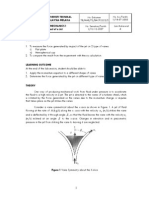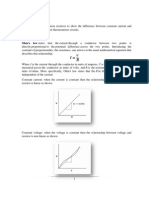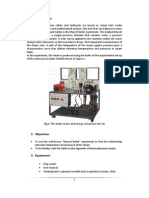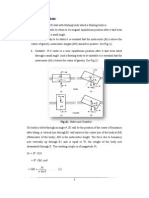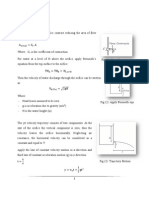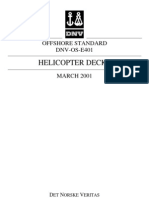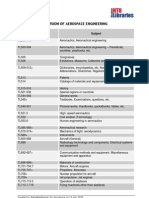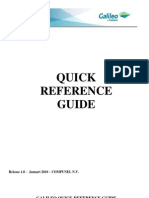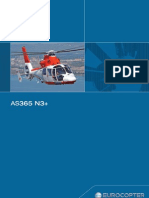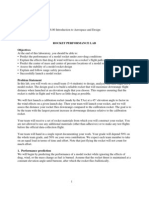Impact of Jet
Impact of Jet
Uploaded by
ميسرةCopyright:
Available Formats
Impact of Jet
Impact of Jet
Uploaded by
ميسرةOriginal Description:
Original Title
Copyright
Available Formats
Share this document
Did you find this document useful?
Is this content inappropriate?
Copyright:
Available Formats
Impact of Jet
Impact of Jet
Uploaded by
ميسرةCopyright:
Available Formats
1.
Purpose:
To investigate the reaction force produced by the impact of a jet of water on various target vanes.
2. Apparatus:
Impact Jet Apparatus (Fig. 1), Targets (Fig. 2).
Figure 1: Impact jet apparatus
Figure 2: Interchangeable Target Vanes
3. Theory:
Figure 3: Impact of a Jet
R 1 - cos Q Vi Q Vn A Vi 2 Vn2 - 2 g h
Where: R: Impulse force. V i : Incident velocity.
Q : Volumetric flow rate.
V n : Jet velocity.
h : Height of target above nozzle.
4. Procedure:
1. Position the weight carrier on the weight platform and add weights until the top of the target is clear of the stop and the weight platform is floating in mid position. Move the pointer so that it is aligned with the weight platform. 2. Start the pump and establish the water flow by steadily opening the bench regulating valve until it is fully open. 3. The vane will now be deflected by the impact of the jet. Place additional weights onto the weight carrier until the weight platform is again floating in mid position. Measure the flow rate (volume collected in certain time) and record the result on the test sheet, together with the corresponding value of additional weight on the tray. Observe the form of the deflected jet and note its shape. 4. Reduce the weight on the weight carrier in steps and maintain balance of the weight platform by regulating the flow rate in about eight or ten even steps (In the lab we
5. 6. 7. 8.
made 3 steps only), each time recording the value of the flow rate and weights on the weight carrier. Close the control valve and switch off the pump. Allow the apparatus to drain. Replace the 5mm nozzle with the 8mm diameter nozzle and repeat the tests. Replace the normal vane with the 45 conical vane and repeat the test with both the 5mm and 8mm nozzles. Replace the 45 conical vane with the hemispherical vane and repeat the test with both the 5mm and 8mm nozzles.
5.
Data & Results:
1. Record the results on a copy of the result sheet provided. 2. Calculate for each result the flow rate and the nozzle exit velocity. Correct the nozzle velocity for the height of the target above the nozzle to obtain the impact velocity. 3. Calculate the impact momentum, and plot graphs of the impact force R against impact momentum and determine the slope of the graphs for each target. Compare with the theoretical values.
M(kg) V(L) T(s) Q(L/s) R(N) Vn(m/s) Vi(m/s) 0.07 10 57 0.175 0.6867 8.91 8.876 0.12 10 48 0.21 1.177 10.7 10.67 0.09 20 122 0.164 0.8829 8.35 8.314
p.Q.Vi H 1.55*10^3 0.03 2.24*10^3 0.03 1.4*10^3 0.03
1.4 1.2 1
R (N)
0.8 0.6 0.4 0.2 0 0 0.5 1 1.5 2 2.5 3 3.5
p.Q.Vi (N)
Y = 0.7193x + 0.0981 Error = (1-0.719)/1)*100 %= 28.1 %
M(kg) V(L) T(s) Q(L/s) R(N) Vn(m/s) Vi(m/s) 0.13 10 83 0.12 1.2753 6.11 6.061 0.27 10 54 0.18 2.6487 9.17 9.137 0.32 10 50 0.2 3.139 10.2 10.17
p.Q.Vi H 0.73*10^3 0.03 1.64*10^3 0.03 2.03*10^3 0.03
3.5 3 2.5
R (N)
2 1.5 1 0.5 0 0 0.5 1 1.5 2 2.5 3 3.5
p.Q.Vi (N)
Y = 0.9319x + 0.4906 Error = (1.707- 0.9319)/ 1.707)*100% = 45.4 %
M(kg) V(L) T(s) Q(L/s) R(N) Vn(m/s) Vi(m/s) 0.02 10 56 0.17 0.1962 8.66 8.63 0.04 10 59 0.169 0.3924 8.61 8.58 0.06 10 47 0.212 0.5886 10.8 10.57
p.Q.Vi H 1.46*10^3 0.025 1.45*10^3 0.025 2.24*10^3 0.025
0.7 0.6 0.5
0.3 0.2 0.1 0 3.5 3 2.5 2 1.5 1 0.5 0
p.Q.Vi (N)
Y = 0.1962x Error = ((0.293 -0.1962)/0.293)*100% = 33.04 %
6. Comments & Recommendations:
Errors founded and may be affected on a results in the experiment due to many reasons listed below: 1. Zero error: If the setup reading isnt zero at zero load. 2. Human error: if the experimenter red the outputs and calculate incorrectly.
It is recommended to make sure that there is no zero error.
R (N)
0.4
You might also like
- The Impact of A Jet ExperimentDocument11 pagesThe Impact of A Jet ExperimentAhmad Aizat Khairi100% (3)
- AE 341 Lab2 Herschel Venturi MeterDocument8 pagesAE 341 Lab2 Herschel Venturi MeterMuhammad Suleet100% (2)
- A320 SystemsDocument4 pagesA320 SystemsHarshenDesai100% (10)
- Weight and Balance Manual: Including Saab-Fairchild 340A Saab SF 340A Saab 340BDocument328 pagesWeight and Balance Manual: Including Saab-Fairchild 340A Saab SF 340A Saab 340BOleh Dmitriiev100% (4)
- Steam Plant Alalysis ReportDocument17 pagesSteam Plant Alalysis Reportميسرة100% (12)
- Fluids Lab - Experiment 3 - Center of Pressure On A Submerged Plane SurfaceDocument9 pagesFluids Lab - Experiment 3 - Center of Pressure On A Submerged Plane SurfaceJordan Hines72% (25)
- Bernouli Lab ReportDocument18 pagesBernouli Lab ReportUgeswran Thamalinggam100% (3)
- Fluid Mechanics - Impact of Jet Vanes - ExperimentDocument4 pagesFluid Mechanics - Impact of Jet Vanes - ExperimentRavi Agarwal96% (24)
- Experiment 3 - Jet ImpactDocument18 pagesExperiment 3 - Jet ImpactKhairil Ikram75% (4)
- NTC Thermistor Linearity ReportDocument6 pagesNTC Thermistor Linearity Reportميسرة0% (1)
- Demostration of Boyle's Law ReportDocument5 pagesDemostration of Boyle's Law ReportميسرةNo ratings yet
- PRT Simulation, Two, Three and Four Wire Connecction ReportDocument6 pagesPRT Simulation, Two, Three and Four Wire Connecction Reportميسرة80% (5)
- PRT Calibration ReportDocument7 pagesPRT Calibration Reportميسرة100% (6)
- Rubber in Shear ReportDocument5 pagesRubber in Shear Reportميسرة86% (7)
- EASA Part 66 Licence, From Licence by PostDocument7 pagesEASA Part 66 Licence, From Licence by PostHussainAhmed100% (1)
- Impact of A Water JetDocument5 pagesImpact of A Water JetAnirban SardarNo ratings yet
- Swinburne University of Technology: School of Engineering (Sarawak Campus)Document19 pagesSwinburne University of Technology: School of Engineering (Sarawak Campus)Mahfuzah MustaphaNo ratings yet
- Exp3 Jet ImpactDocument17 pagesExp3 Jet ImpactAnusha AnuNo ratings yet
- Impact of A JetDocument11 pagesImpact of A JetMuhammad Hakim Jaffar0% (1)
- 42 Experiment #5: Impact of A JetDocument7 pages42 Experiment #5: Impact of A JetYasir A. Al-ShataifNo ratings yet
- Fluids Lab - Experiment 4 - Impact of A Jet of WaterDocument9 pagesFluids Lab - Experiment 4 - Impact of A Jet of WaterJordan Hines50% (2)
- Lab 4 Formal ReportDocument14 pagesLab 4 Formal ReportMohd Haikal ShukorNo ratings yet
- Impact of JetDocument8 pagesImpact of JetOmar Faruqi100% (1)
- Mechanics of Fluids Lab Impact of A JetDocument10 pagesMechanics of Fluids Lab Impact of A JetpatrickNX942088% (17)
- Lab Report Energy Loss in Pipe and FittingsDocument15 pagesLab Report Energy Loss in Pipe and FittingsAnis ThuraiyaNo ratings yet
- Fluid Mechanics Exam 2Document8 pagesFluid Mechanics Exam 2Diego FungNo ratings yet
- Impact of JetDocument8 pagesImpact of Jetpravishek maniNo ratings yet
- Bernoulli's ExperimentDocument29 pagesBernoulli's ExperimentAnonymous NyvKBWNo ratings yet
- Venturi Meter Experiment ProceduresDocument2 pagesVenturi Meter Experiment ProceduresAnonymous mRBbdopMKf100% (1)
- Introduction Impact JetDocument4 pagesIntroduction Impact JetIniaan SaminathanNo ratings yet
- AbstractDocument9 pagesAbstractEssam Ahmed Abd MeguidNo ratings yet
- Hydrostatic ForceDocument6 pagesHydrostatic ForceAhmad MuzakkirNo ratings yet
- Impact of A JetDocument12 pagesImpact of A Jetmuhd nizamNo ratings yet
- Lab 1 - Impact of JetDocument7 pagesLab 1 - Impact of JetMichael York100% (1)
- Orfice Free Jet FlowDocument17 pagesOrfice Free Jet Flowshekhynahcurtis80% (5)
- Determination of Reynolds NUmberDocument6 pagesDetermination of Reynolds NUmbermujette godmalin100% (5)
- VENTURIMETERDocument10 pagesVENTURIMETERKrishan PrajapatiNo ratings yet
- Impact of JetDocument8 pagesImpact of JetbandarNo ratings yet
- MEHB221 Thermofluids Lab 2012Document6 pagesMEHB221 Thermofluids Lab 2012Asyraf Hakim Muhammad Azmi50% (2)
- Flow Demonstration ExperimentDocument5 pagesFlow Demonstration ExperimentVictoria SooknananNo ratings yet
- Fric Flow Ours FINAL VR 2Document14 pagesFric Flow Ours FINAL VR 2Edwin Jesu DassNo ratings yet
- Weir Experiments.02Document14 pagesWeir Experiments.02alex100% (2)
- Fluid Mechanics: Impact of JetsDocument11 pagesFluid Mechanics: Impact of Jetsjoshx12No ratings yet
- Flow Through A Venturi MeterDocument10 pagesFlow Through A Venturi MeterOmar Saleem78% (9)
- Centre of Pressure Level 1Document12 pagesCentre of Pressure Level 1Mohd Azeem RizalNo ratings yet
- Orifice and Free Jet Flow Experiment: Updated 8/9/06Document3 pagesOrifice and Free Jet Flow Experiment: Updated 8/9/06shaneshaneshaneshaneNo ratings yet
- Bernoulli's TheoremDocument5 pagesBernoulli's TheoremVrushiket PatilNo ratings yet
- Open Channel Flow Report Lab PDF FreeDocument16 pagesOpen Channel Flow Report Lab PDF FreelucaggNo ratings yet
- Reynold Number Experiment ReportDocument5 pagesReynold Number Experiment Reportyolandaputriyud4825No ratings yet
- Pipe Friction ApparatusDocument6 pagesPipe Friction ApparatusShubham MauryaNo ratings yet
- EXPERIMENT HydrostaticDocument7 pagesEXPERIMENT HydrostaticinhinyeroNo ratings yet
- Energy Losses in Bends & FittingsDocument7 pagesEnergy Losses in Bends & Fittingssamama khan100% (1)
- Experiment - Fre and Forced Vortex UitmDocument22 pagesExperiment - Fre and Forced Vortex UitmAdil Rahman100% (1)
- Free & Forced Vortices: ManualDocument11 pagesFree & Forced Vortices: ManualMahadevan100% (1)
- Lab Report 2Document16 pagesLab Report 2Limmy Yingran0% (1)
- Experiment Center Pressure Lab ReportDocument9 pagesExperiment Center Pressure Lab ReportAyong Anis100% (4)
- F9092 - Fluid Properties & Hydrostatics BenchDocument4 pagesF9092 - Fluid Properties & Hydrostatics Benchindra98031No ratings yet
- 12 Experiment #2: Bernoulli'S Theorem DemonstrationDocument12 pages12 Experiment #2: Bernoulli'S Theorem DemonstrationYasir A. Al-ShataifNo ratings yet
- Pipe FrictionDocument4 pagesPipe FrictionShubham ChauhanNo ratings yet
- Impact of Jet On VanesDocument5 pagesImpact of Jet On Vanesanil chejara100% (7)
- Fluids 2 Experiment 3Document8 pagesFluids 2 Experiment 3Bench CiudadanoNo ratings yet
- Experiment Impact JetDocument7 pagesExperiment Impact Jetpeniel ccNo ratings yet
- Exp 3 - Impact of A Jet - NewDocument5 pagesExp 3 - Impact of A Jet - NewaadhanNo ratings yet
- Experiment no 2 - CopyDocument6 pagesExperiment no 2 - CopyRohit PahadiNo ratings yet
- Final FMHM LAB MANUAL Manual of 1Document67 pagesFinal FMHM LAB MANUAL Manual of 1Motee SinghNo ratings yet
- Impact of JetDocument12 pagesImpact of JetShafizNo ratings yet
- Lab 5 - CDocument8 pagesLab 5 - Cnoor shyahdaNo ratings yet
- Enhanced Oil Recovery: Resonance Macro- and Micro-Mechanics of Petroleum ReservoirsFrom EverandEnhanced Oil Recovery: Resonance Macro- and Micro-Mechanics of Petroleum ReservoirsRating: 5 out of 5 stars5/5 (1)
- Applications of Derivatives Rate of Change (Calculus) Mathematics Question BankFrom EverandApplications of Derivatives Rate of Change (Calculus) Mathematics Question BankNo ratings yet
- Calibration of The Liquid in Glass, Gas (Vapor) Pressure and Bi-Metal DevicesDocument6 pagesCalibration of The Liquid in Glass, Gas (Vapor) Pressure and Bi-Metal Devicesميسرة50% (4)
- Part Simulation, Constant Voltage and Current ReportDocument4 pagesPart Simulation, Constant Voltage and Current Reportميسرة100% (1)
- Minor Losses ReportDocument12 pagesMinor Losses Reportميسرة100% (4)
- Heat Treatment Report PDFDocument5 pagesHeat Treatment Report PDFميسرة82% (17)
- Pressure-Temperature Relationship in Steam Plant ReportDocument4 pagesPressure-Temperature Relationship in Steam Plant Reportميسرة100% (3)
- BUOYANCY & FLOTATION - METACENTRIC HEIGHT ReportDocument8 pagesBUOYANCY & FLOTATION - METACENTRIC HEIGHT Reportميسرة94% (18)
- Flow Over Weirs ReportDocument6 pagesFlow Over Weirs ReportميسرةNo ratings yet
- Control System Design of An Vtol Fixed-Wing AircraftDocument4 pagesControl System Design of An Vtol Fixed-Wing AircraftkhoamaiNo ratings yet
- The Tail Consists of The Horizontal StabilizerDocument8 pagesThe Tail Consists of The Horizontal StabilizerDavid GaytonNo ratings yet
- ME3608 Aeroelasticity #1Document31 pagesME3608 Aeroelasticity #1djtj89No ratings yet
- FAST34Document21 pagesFAST34papaki2No ratings yet
- RV4PX308R Commscope Multiband 2x694-960-8x1695-2690 MHZ PDFDocument4 pagesRV4PX308R Commscope Multiband 2x694-960-8x1695-2690 MHZ PDFAlfredoNo ratings yet
- Os-E401 Helicopter DeckDocument26 pagesOs-E401 Helicopter DeckAnitya AulianaNo ratings yet
- ATR Special Tools CalibrationDocument9 pagesATR Special Tools Calibrationmpus0% (1)
- Runway LengthDocument7 pagesRunway LengthRana ImamNo ratings yet
- Tutorial PE104Document7 pagesTutorial PE104aquabeefmanNo ratings yet
- Introduction To Renewable Energy Problem Set 3Document3 pagesIntroduction To Renewable Energy Problem Set 3Supun MadushankaNo ratings yet
- Cessna 150 ChecklistDocument2 pagesCessna 150 ChecklistnicholaswirzNo ratings yet
- GEP0370-Lesson-6a - ATC FIS - AFISDocument23 pagesGEP0370-Lesson-6a - ATC FIS - AFISBeril TiryakiNo ratings yet
- Division of Aerospace EngineeringDocument2 pagesDivision of Aerospace EngineeringNTUSubjectRooms100% (1)
- Galileo QRGDocument18 pagesGalileo QRGAmit K BaswalkarNo ratings yet
- AC 33 14-1 CHG 1Document81 pagesAC 33 14-1 CHG 1burchandadiNo ratings yet
- Spacecraft Attitude Dynamics and Control: Christopher D. Hall January 16, 2000Document17 pagesSpacecraft Attitude Dynamics and Control: Christopher D. Hall January 16, 2000Bernardo SabinoNo ratings yet
- Sami 2020-04Document116 pagesSami 2020-04Doru Sicoe100% (6)
- Hydraulic and Compressible Flow Turbomachines PDFDocument146 pagesHydraulic and Compressible Flow Turbomachines PDFThomasCarry67% (3)
- Answer:: DLM SeriesDocument2 pagesAnswer:: DLM SeriesDavidLomazziNo ratings yet
- Brochre AS365 N3Document20 pagesBrochre AS365 N3Júlio Gallinaro MaranhoNo ratings yet
- Flight Airworthiness Support Technology: December 2007Document23 pagesFlight Airworthiness Support Technology: December 2007Jason JiaNo ratings yet
- Anatomy of A Stol AircraftDocument8 pagesAnatomy of A Stol AircraftMaicon100% (1)
- Design and Analysis of Remotely Amphibious DroneDocument5 pagesDesign and Analysis of Remotely Amphibious DroneRajesh DommetiNo ratings yet
- Autopilot Flight Director System CH 22: Training Manual B767-3S2F Ata 22-00Document155 pagesAutopilot Flight Director System CH 22: Training Manual B767-3S2F Ata 22-00David Owen100% (1)
- Dimensioning of A Furling System For A Small Wind TurbineDocument19 pagesDimensioning of A Furling System For A Small Wind TurbineFlorian RoscheckNo ratings yet
- Rocket Lab 2003Document4 pagesRocket Lab 2003api-26088064No ratings yet
- Ca Final Presentation: Topic: How Gulfstream G650ER Is Significant For PARCO?Document16 pagesCa Final Presentation: Topic: How Gulfstream G650ER Is Significant For PARCO?Syeda Azka AliNo ratings yet


